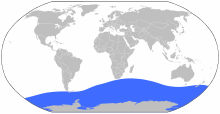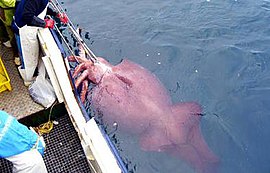Colossal squid
| Colossal squid | |
|---|---|
 | |
| Scientific classification | |
| Kingdom: | Animalia |
| Phylum: | Mollusca |
| Class: | Cephalopoda |
| Order: | Teuthida |
| Family: | Cranchiidae |
| Subfamily: | Taoniinae |
| Genus: | Mesonychoteuthis Robson, 1925 |
| Species: | M. hamiltoni |
| Binomial name | |
| Mesonychoteuthis hamiltoni Robson, 1925 | |
 | |
| Global range of M. hamiltoni | |
Morphology
Unlike the giant squid, whose arms and tentacles only have suckers lined with small teeth, the colossal squid's limbs are also equipped with sharp hooks: some swivelling, others three-pointed.[2] Its body is wider and stouter, and therefore heavier, than that of the giant squid. Colossal squid are believed to have longer mantles than giant squid, although their tentacles are shorter.The squid exhibits abyssal gigantism. The beak of Mesonychoteuthis hamiltoni is the largest known of any squid, exceeding that of Architeuthis (giant squid) in size and in robustness. The colossal squid also has the largest eyes documented in the animal kingdom; a partly collapsed specimen measured 27 centimetres (11 in).[3][4]
Distribution
The squid's known range extends thousands of kilometres northward from Antarctica to southern South America, southern South Africa, and the southern tip of New Zealand, making it primarily an inhabitant of the entire circumantarctic Southern Ocean.Ecology and life history
Little is known about the life of this creature, but it is believed to feed on prey such as chaetognatha, large fish like the Patagonian toothfish, and other squid in the deep ocean using bioluminescence. The colossal squid is thought to have a slow metabolic rate, needing only around 30 g of prey daily.[5] Estimates of its energetic demands suggest that it is a slow-moving ambush predator, using its large eyes primarily for predator detection rather than active hunting.[5][6]Based on capture depths of a few specimens, and beaks found in sperm whale stomachs, the adult colossal squid ranges at least to a depth of 2.2 kilometres (7,200 ft), and juveniles can go as deep as 1 kilometre (3,300 ft). It is believed to be sexually dimorphic, with mature females generally being much larger than mature males, as is common in many species of invertebrates.
The squid's method of reproduction has not been observed, although some data on their reproduction can be inferred from anatomy. Since males lack an organ called a hectocotylus (an arm used in other cephalopods to transfer a spermatophore to the female), they probably use a penis instead, which would be used to directly implant sperm into females.
Many sperm whales carry scars on their backs believed to be caused by the hooks of colossal squid. Colossal squid are a major prey item for Antarctic sperm whales feeding in the Southern Ocean; 14% of the squid beaks found in the stomachs of these sperm whales are those of the colossal squid, which indicates that colossal squid make up 77% of the biomass consumed by these whales.[7] Many other animals also feed on this squid, including beaked whales (such as the bottlenose whales), pilot whales, southern elephant seals, Patagonian toothfish, sleeper sharks (Somniosus antarcticus), and albatrosses (e.g., the Wandering and Sooty albatrosses). However, beaks from mature adults have only been recovered from those animals large enough to take such prey (i.e. sperm whales and sleeper sharks), while the remaining predators are limited to eating juveniles or young adults.[8]
Timeline
Main article: List of colossal squid specimens and sightings
- 1925 – Species was first discovered in the form of two tentacles found in the stomach of a sperm whale.[9]
- 1981 – A Russian trawler in the Ross Sea, off the coast of Antarctica, caught a large squid with a total length of 4 metres (13 ft), which was later identified as an immature female of Mesonychoteuthis hamiltoni.[10]
- 2003 – A complete specimen of a subadult female was found near the surface with a total length of 6 m (20 ft) and a mantle length of 2.5 m (8.2 ft).[11]
- 2005 – A specimen was captured at a depth of 1,625 m (5,331 ft) while taking a toothfish from a longline off South Georgia Island. Although the mantle was not brought aboard, the mantle length was estimated at over 2.5 m (8.2 ft), and the tentacles measured 2.3 m (7.5 ft). The animal is thought to have weighed between 150 and 200 kilograms (330 and 440 lb).[12]
- 2007 – The largest recorded specimen was captured by a New Zealand fishing boat off Antarctica. It was initially estimated to measure 10 m (33 ft) in length and weigh 450 kg (990 lb). The squid was taken back to New Zealand for scientific study.[13] A study on the specimen later showed that its actual weight was 495 kg (1,090 lb), but that it only measured 4.2 m (14 ft) in total length as a result of the tentacles shrinking post mortem.[14]
Largest known specimen
See also: Cephalopod size

This specimen, caught in early 2007, is the largest cephalopod ever recorded. Here it is shown in its live state during capture, with the delicate red skin still intact and the mantle characteristically inflated.
Defrosting and dissection, April–May 2008
Thawing and dissection of the specimen took place at the Museum of New Zealand Te Papa Tongarewa[20] under the direction of senior biologist Chris Paulin, with technician Mark Fenwick, Dutch marine biologist and toxicologist Olaf Blaauw, AUT biologist Steve O'Shea, Tsunemi Kubodera, and AUT biologist Kat Bolstad.Parts of the specimen have been examined:
- The beak is considerably smaller than some found in the stomachs of sperm whales,[22][23] suggesting there are colossal squid much larger than this one.[22][23]
- The eye is 27 cm (10.63 in) wide, with a lens 12 cm across. This is the largest eye of any known animal.[3] These measurements are of the partly collapsed specimen: when living the eye was probably 30[4] to 40 cm (12 to 16 in) across.[24]
- Inspection of the specimen with an endoscope revealed ovaries containing thousands of eggs.[4]
Exhibition

The specimen on display at the Museum of New Zealand Te Papa Tongarewa
No comments:
Post a Comment